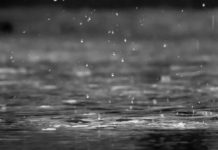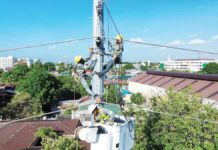ILOILO City – The daily removal of unwelcome green algae carpeting Boracay’s shores won’t do it, according to a marine biology expert at the University of the Philippines Visayas (UPV).
“It is a waste of time. If the cause of water pollution is not solved, the algae will keep on returning,” said Dr. Resurreccion Sadaba, professor at the Division of Biological Sciences, College of Arts & Sciences, UPV.
Each day since the start of Boracay’s closure on April 26 for six months of rehabilitation, workers tapped by the Department of Environment and Natural Resources (DENR) gather green algae covering the island’s white-sand shores. The following morning, however, more algae are washed ashore.
The culprit, according to Sadaba, is the untreated wastewater being discharged into the sea surrounding Boracay.
Algae feed on this untreated wastewater from resorts and residences, said Sadaba, a marine biology expert who helped revive mangroves in Guimaras when the island province was hit by a massive oil spill in 2006.
He likened the daily effort to remove the algae in Boracay to “just treating the symptoms but not disease itself.”
“The disease is really the failure on wastewater treatment,” said Sadaba whose expertise was also tapped by the provincial government of Iloilo when the northern part of the province was struck by an oil spill in the aftermath of super typhoon “Yolanda” in 2013.
SOLUTION
Centralized wastewater treatment could reduce if not eliminate the growth of green algae, said Sadaba.
The wastewater discharge problem did not come as a surprise to Sadaba who has studied the algae phenomenon in Boracay.
“I suggested a long time ago for the real-time monitoring of phosphate and nitrate levels in Boracay’s waters because these give nutrients for algae to bloom,” he said.
Getting rid of the algae won’t happen overnight, said Sadaba.
“It will take some time…kun asta san-o tanan nga nutrients (phosphate and nitrate) madula. Kay kun wala na makaon ang algae, paano pa na sila magdamo,” he said.
The high level of coliform bacteria in Boracay’s waters is also a result of the dumping of untreated wastewater into the sea, added Sadaba.
The current water treatment facility in the island treats only a small percentage of wastewater produced in Boracay, he said.
He observed that only a few establishments are connected to the facility.
The green algae’s presence particularly on the shores is expected, added Sadaba.
“Ara sya sa kilid kay dira man directly ang discharge, which is bad kay dira man ang tawo gapaligo sa kilid,” he explained.
As for how long it would take to see improvements in Boracay, Sadaba said it would be better to set goals or targets.
“Ano gid bala ang gusto naton matabo (What is it that we really want to accomplish),” he said.
But six months may be too short, he said, adding that it is not clear what the government really wants to do first on the island.
It would do DENR good to consult the experts, said Sadaba.
He stressed the importance of conducting a scientific assessment on Boracay.
“There are so many experts in this field in the Visayas who could certainly help solve Boracay’s environmental problems,” he stressed.
GREEN ALGAE MAKE BORACAY SAND WHITE?
Salaba dismissed the belief of the island’s residents and some stakeholders that green algae makes Boracay’s sand white or turn to white sand itself.
“That is not true. Algae have nothing to do with sand. Boracay’s white sand comes from coral reefs that produce silica. Algae do not produce silica,” he stressed. “Wrong gid ang belief nga mag-decompose ang algae ma-turn sa white sand. Ano ina, magic?”
Boracay Foundation, Inc., a business industry association on the island, tried to play down the presence of algae in the island as seasonal.
This phenomenon had been observed by the locals even before Boracay became a prime destination flocked by tourists and crowded with development, it stressed.
“Scientifically, green algal bloom is linked to the high nutrient load of the water. Usually with calm and warm waters, coupled with intense light during summer, these green algae consume excess nutrients from the water and process it for their growth and reproduction. In fact this equates to their proliferation…The presence of these algae is nature’s way of balancing the problem of high nutrient content in the water,” read part of the brochure prepared by the foundation specifically made to address concerns over Boracay’s green algae./PN




We have experts who can help clean wastewater before discharge to Boracay water. Visit our website www. greendevsolutions.com or call 09209461680
In my experience in Boracay, I saw that baby green algaes cultivates in private swimming pools of the resorts. Unwanted, the resorts flush the baby algaes to the sea. At sea they mature and washed ashore.
A well informed article and we hope a proper scientific assessment concerning the increasing proliferation of algae is undertaken asap. Removing the algae I think is good for aesthetic purposes but then burying it in the sand is maybe doing more harm than good. The locals firmly believe that burying the algae makes the sand white so serious re-education needs to occur on Boracay.
As Green Algae high in Nitrogen and Phosphates it is a very good fertilizer so it should be given to the local farmers to put on their crops.
Algae or seaweed feeds from the wastewater being disposed to the sea.The volume of seaweed is an indicator of more wastewater that they feed on. By feeding on the wastewater, it is a good agent in cleaning the seawater back to the normal level. Seaweed is used as an ingredient in making fertilizer. Removing it from the shore does not help in reducing its multiplication. You have to starve them of their food, the wastewater, if you want to control their growth.
Treat the problem at the source. I agree with Dr. Sadaba who happens to be a friend and classmate at UPLB Envi Sci. There are so many experts/environmental scientists in the Visayas. The govt can consult them.
I agree with Dr. Sadaba. This article is worth reading. Boracay is far different when my first visit way back 1997 compared today! Let us help inculcate to the minds of the new generation the character of anticipation and participation! Boracay needs youth who possessed global thinking skills.
Do you know the name of the environmental expert who recommended that they gather up all the marine algae in Boracay to get rid of the algal bloom? Si Mocha Uson? Bwahahaha! 😂😂😂🤣🤣🤣
It’s now November 2018. And the government agencies are finally doing a cleanup. Which has to be maintained to prevent re-occurrence. Like president D30 said it’s a cesspool.
Two bawdy euro harlots share one meaty hard dick
Chubby Brunette Kailie Raynes Loves a Hard Dick Inside Her
Kinky Holly West enjoys sex toys and anal
Sultry babe with perky tits fucked in the car for money
Small tit blonde teen with glasses sucks soft dick of a horny older man
Pleasing asian darling groans as man fucks her
Teen babe makes you cum in POV
Big Tits Slut Real Homemade Sex Tape on Couch